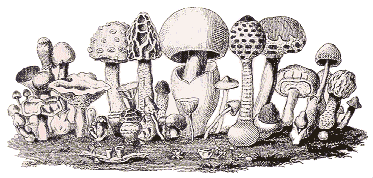Saturday 2nd September. Risley Moss
First catch your Leccinum. The hunting party, led by Rita Cook, fanned out across Risley Moss in search of an elusive prey, THE LECCINUM. By lunchtime the weary party had only two successes, expertly trapped by the fearless Sherry Stannard. Undaunted the party set off to Rixton Claypits where again Sherry showed her skill by coaxing yet another specimen from its grassy hiding place. The bedraggled specimens were examined for their cap colours, stipe squamules and stem basal colours before being imprisoned overnight in Rita's fridge. At least the weather was good.
Sunday 3rd September. Risley Moss
Fortunately, Robin Dean had been scouring the canal banks in the early morning and trapped some fresh specimens to supplement the previous day's haul. Ken Jordan had some dried examples from Mere Sands and Tony Carter produced a week old one which smelled as if it had been found at Fleetwood fish quay. All were labelled and laid before the nine excited microscopists. All werecut in two and one half bruised. Then, Kibby keys in hand, we watched and waited for any flesh colour changes.
The group had a lively discussion about the cap colour of the largest specimen, but as it's poor condition precluded further examination the majority verdict was of dubious value. We had quickly learnt the first rule if your specimen is not good, your examination will not be good. Most of our specimens were consigned to the wastepaper bin.
Attention turned to the best of the specimens, a dark brown cap - C. (all agreed so far).
Stipe squamules black on a pale background - H. (all agreed so far) Basal stem colour green - K (all agreed so far although it was suggested that we should acquire a slug to assist in this examination)
Flesh colour. Now it got tricky. All agreed an O but it took a little while for the blue green to appear in the base of the stipe. And who forgot to rub the cap??
Finally the bit the microscopists had been waiting for, congo red at the ready. There was much discussion as to the best way to take a sample. Some took a section and separated the cuticle from the flesh, one took a scrape, others prepared a thin slice so that the line between cuticle and flesh could be seen. The last method impressed but we all got a result. The cap cells were short and bricklike, disarticulation present - R.(Hurrah!! All agreed)
CHKOR- See Key 7. (and we thought we had finished)
The stipe was not pale grey but black. There was no olivaceous flush. CONCLUSION - Leccinum variicolor. (Who said roseofractum. ?)
The key appeared to work but more by elimination in this particular specimen. The flesh could not be described as bright pink but the tests best fitted variicolor rather than the other candidates.
Now for specimen No.2, an orange cap - B. (all agreed so far)
Stipe squamules black on a pale background - H (all agreed so far)
Basal stem colour blue-green - K ( all agreed)
Flesh colour slate grey - P (all agreed)
Now for the coup de grace, microscopes ready. Cap cells were long - Q (all agreed)
BHKPQ- CONCLUSION- NO SUCH FUNGUS according to the Kibby key.
Where did we go wrong? We were all agreed.
The cells were certainly long, much longer than the short ones in the variicolor and the fishy one which someone bravely examined for another comparison. The answer appears to lie in the definitions of short, length 3 to 4 times width and long - length more than 5 times width.
Both these figures are for the average number of cells. A measurement of Tony Carter's finger showed that it was only 4 times it's width but it looked long. It is therefore necessary to measure a good proportion of the cells to establish exactly what size the average is.
We eventually concluded that we had probably got the last test wrong and the specimen was versipelle, BHKPR, the only choice really. However we have sent our specimen and observations to Geoffrey Kibby hoping for further clarification.
It only took a few minutes to polish off the last specimen CHLMQ - scabrum.
CONCLUSIONS
1. Get a good specimen.
2. Keep a full note of colours, which could change by the time you get home, especially squamules.
3. Check for even the slightest blue green in the basal stem. (with or without slugs)
4. Be patient waiting for colour changes in the flesh, it can take hours. Make sure you observe at regular intervals.
5. Keep a full note of these changes as they will be important when you move on to the next set of keys and the species notes. You may have to make a choice based on these observations.
6. Make measurements of the length/width ratio of a number of cap cells to ensure you find an average. You may be left with a majority decision.
7. Keep full notes. The key may be updated in the future and you may be able to review your previous conclusions.
